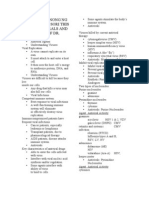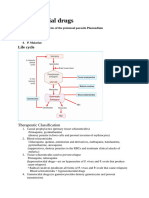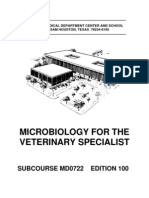0 ratings0% found this document useful (0 votes)
18 viewsRevision Study Material Unit - X: Anti-Viral & HIV Drugs
Revision Study Material Unit - X: Anti-Viral & HIV Drugs
Uploaded by
Magesh SThis document discusses various anti-viral and anti-HIV drugs. It describes Gossypol, which is derived from cotton plants and inhibits HIV replication. Hypericin is isolated from St. John's Wort and is a potent antiretroviral agent. Inophyllums from Calophyllum inophyllum inhibit HIV reverse transcriptase. Calanolide A and B are isolated from trees in Malaysia and are non-nucleoside reverse transcriptase inhibitors of HIV. Vidarabine is an antibiotic that has activity against DNA viruses. Glycyrrhizin is derived from licorice root and has proven anti-viral activity against various viruses. Several other compounds from marine sources such as sponges
Copyright:
© All Rights Reserved
Available Formats
Download as PPT, PDF, TXT or read online from Scribd
Revision Study Material Unit - X: Anti-Viral & HIV Drugs
Revision Study Material Unit - X: Anti-Viral & HIV Drugs
Uploaded by
Magesh S0 ratings0% found this document useful (0 votes)
18 views16 pagesThis document discusses various anti-viral and anti-HIV drugs. It describes Gossypol, which is derived from cotton plants and inhibits HIV replication. Hypericin is isolated from St. John's Wort and is a potent antiretroviral agent. Inophyllums from Calophyllum inophyllum inhibit HIV reverse transcriptase. Calanolide A and B are isolated from trees in Malaysia and are non-nucleoside reverse transcriptase inhibitors of HIV. Vidarabine is an antibiotic that has activity against DNA viruses. Glycyrrhizin is derived from licorice root and has proven anti-viral activity against various viruses. Several other compounds from marine sources such as sponges
Original Title
Anti-Viral Drugs
Copyright
© © All Rights Reserved
Available Formats
PPT, PDF, TXT or read online from Scribd
Share this document
Did you find this document useful?
Is this content inappropriate?
This document discusses various anti-viral and anti-HIV drugs. It describes Gossypol, which is derived from cotton plants and inhibits HIV replication. Hypericin is isolated from St. John's Wort and is a potent antiretroviral agent. Inophyllums from Calophyllum inophyllum inhibit HIV reverse transcriptase. Calanolide A and B are isolated from trees in Malaysia and are non-nucleoside reverse transcriptase inhibitors of HIV. Vidarabine is an antibiotic that has activity against DNA viruses. Glycyrrhizin is derived from licorice root and has proven anti-viral activity against various viruses. Several other compounds from marine sources such as sponges
Copyright:
© All Rights Reserved
Available Formats
Download as PPT, PDF, TXT or read online from Scribd
Download as ppt, pdf, or txt
0 ratings0% found this document useful (0 votes)
18 views16 pagesRevision Study Material Unit - X: Anti-Viral & HIV Drugs
Revision Study Material Unit - X: Anti-Viral & HIV Drugs
Uploaded by
Magesh SThis document discusses various anti-viral and anti-HIV drugs. It describes Gossypol, which is derived from cotton plants and inhibits HIV replication. Hypericin is isolated from St. John's Wort and is a potent antiretroviral agent. Inophyllums from Calophyllum inophyllum inhibit HIV reverse transcriptase. Calanolide A and B are isolated from trees in Malaysia and are non-nucleoside reverse transcriptase inhibitors of HIV. Vidarabine is an antibiotic that has activity against DNA viruses. Glycyrrhizin is derived from licorice root and has proven anti-viral activity against various viruses. Several other compounds from marine sources such as sponges
Copyright:
© All Rights Reserved
Available Formats
Download as PPT, PDF, TXT or read online from Scribd
Download as ppt, pdf, or txt
You are on page 1of 16
REVISION STUDY MATERIAL
UNIT - X
Anti-Viral & HIV Drugs
1. Gossypol
• Gossypol is a natural phenol derived from the
seeds of cotton plant (genus Gossypium)..
• Cotton plants produce gossypol in order to slow
down the reproduction of the insects that eat cotton
bolls and seeds.
• The compound also affects reproduction in
mammals. The oil of Gossypium seed affected male
fertility due to the presence of contraceptive
compound gossypol.
• Gossypol is a phenolic aldehyde that permeates
cells and acts as an inhibitor for several
dehydrogenase enzymes.
• It is a yellow pigment.
USES:-
•It inhibits replication of the HIV-1 virus.
•It also causes low potassium levels, and thus
causes temporary paralysis.
•Gossypol is antimalarial being the selective
inhibitor of Plasmodium falciparum (pfLDH over
hLDHs), an essential enzyme for energy generation
within malarial parasite.
.
2. Hypericin
• Hypericin is a napthodianthrone isolated from
Hypericum perforatum (St John's Wort)
• It occurs as a red dye and forms hypercinate salts
with sodium and potassium. .
• Hypericin is a natural photosensitizer
• It is a potent antiretroviral agent.
• Hypericin a prime candidate for clinical application
in the treatment of human glioma tumors.
• Hypericin is reported to interact with DNA in vitro
and in intact cells.
• Hypericin accumulates preferentially in cancerous
tissues, it is also used as an indicator of cancerous
cells.
Biological Activity
• Photosensitive antiviral, anticancer and
antidepressant agent derived from
Hypericum perforatum.
• Inactivates enveloped viruses (including
HIV), inhibits tyrosine kinases and is
preferentially cytotoxic to tumor cells upon
stimulation by visible light.
3. Inophyllum (Calophyllum inophyllum)
• Inophyllums B and A inhibited HIVreverse
transcriptase, which was isolated from
Tamanu (Calophyllum inophyllum).
• The root bark contains and antibacterial
principle .
• The plant is also reported to have novel
inhibitors of HIV-1reverse transcriptase.
• The plant contains 4- phenylcoumarins that
have antitumour activity
Uses
• Anti viral
•Active ingredients in the oil are believed to
regenerate tissue, used in skin creams.
•The gum resin is said to be good for old sores and
wounds.
• The resin may be useful for chronic catarrh.
•It is used in decoction for internal haemorrhages
and as a wash for indolent ulcers.
4. Calanolide A & B
• Calanolide A & B are the new non-nucleoside
reverse transcriptase inhibitor (NNRTI) first
acquired from Calophyllum lanigerum trees in
Malaysia.
• The U.S. National Cancer Institute tested
calanolide as a possible cancer treatment
• It was later found to have potent anti-HIV
activity.
• Calanolide A is unique among NNRTIs in that it
may bind two distinct sites in reverse
transcriptase
Calanolide A
Botany
• Calanolide A is a compound isolated from the latex of
the tree, Calophyllum lanigerum var. austrocoriaceum
• Grows in the rain forest of the Malaysian state of
Sarawak on the island of Borneo.
Chemistry
• Contain xanthones, steroids, triterpenes, coumarins,
and benzopyrans.
• Calanolide A falls into the category of a
dipyranocoumarin.
• It is classified as a nonnucleoside HIV-1 specific reverse
transcriptase (RT) inhibitor.
Uses
• Initial studies show promise for treating HIV-1
HIV
• Calanolide A has been found to inhibit a wide variety of HIV-
1 strains, drug-resistant strains, and HIV disease in various
stages.
• It is in a category of HIV medicines called non-nucleoside
reverse transcriptase inhibitors (NNRTIs).
• Calanolide A prevents HIV from entering the nucleus of
healthy T-cells.
• This prevents the cells from producing new virus and
decreases the amount of virus in the body.
Calanolide B
• Calanolide B - a novel and naturally-occurring non-
nucleoside reverse transcriptase inhibitor of HIV-1. (NNRTI)
• Obtain from the latex of Calophyllum teysmannii var.
5.Vidarabine
• A nucleoside antibiotic isolated from Streptomyces
antibioticus.
• It has some antineoplastic properties and has broad
spectrum activity against DNA viruses in cell cultures
and significant antiviral activity against infections
caused by a variety of viruses such as the herpes
viruses, the vaccinia VIRUS and varicella zoster
virus.
The Mechanism of Action of Vidarabine
• Vidarabine works by interfering with the synthesis of
viral DNA.
USES
• Vidarabine is an antiviral used in treating eye
infections caused by herpes simplex virus
• It is also used to treat herpes encephalitis,
although the drug acyclovir has proven more
effective as a therapy for this disease.
• Vidarabine's brand name is Vira A.
Ophthalmic Ointment
• Vidarabine is indicated for the treatment of acute
keratoconjunctivitis and recurrent epithelial
keratitis due to Herpes simplex virus
6. Glycyrrhizin
• Glycyrrhizin is the main sweet-tasting compound
from Glychyrrhiza glabra (licorice root).
• Glycyrrhizin is a triterpenoid saponin glycoside of
glycyrrhizic (or glycyrrhizinic) acid.
• On hydrolysis, the glycoside loses its sweet taste
and is converted to the aglycone glycyrrhetinic
acid plus two molecules of glucuronic acid.
• Chemically, glycyrrhizin is sulphated
polysaccharide
Anti-viral activity & Anti HIV activity
• It has been proven to have antiviral activity against DNA
and RNA virus (VZV, HIV, Influenza A and B, types 1 and 2
herpes simplex and hepatitis B and C) in vitro an in vivo
ANTI VIRAL & ANTI HIV
• Tethya crypta –Ara-A – Anti viral
• Tridi demnum – diademnis – Antiviral
• Budistoma olivaceum – Eudistomin A – Inhibit
immuno deficiency virus – AIDS
• Distea avara (sponge) – Evarol, Evarone –Anti
HIV –AIDS
• Ascidian lissocilium – Patellazole –B –Simplex
virus
• Laminaria Brown algae – Inhibit DNA, RNA
development, HIV, Simplex
Ara –A Didemins
Semisynthetic anti viral agent Cyclic depsi peptides
Arabinosyl nuclioside isolated Didemnin anti tumor agent
from marine sponge Tethya
crypta Isolated from Tridi demnum
Eudistomins & B- Avarol & avarone
Carbolin Sesquiterpene benzenoids
o Isolated from sponge Derived from Disidea avara
o Eudistoma olivaceum
Anti HIV
Polycitoridae
Inhibit immuno deficiency virus
Patellazole B
Laurenterol
Ophioderma variegata Complex derivative isolated
Antibacterial activity from Lissoclinum pattela
Active against simplex
You might also like
- Coronavirus (COVID-19) RecordsDocument1 pageCoronavirus (COVID-19) RecordssalwaNo ratings yet
- Chemotherapy - 2Document90 pagesChemotherapy - 2shNo ratings yet
- Antiviral DrugsDocument36 pagesAntiviral DrugsechsrykNo ratings yet
- Anti AIDS HerbsDocument6 pagesAnti AIDS Herbskhansa maryamNo ratings yet
- Antiviral Chemotherapy (Udy) - 114411Document37 pagesAntiviral Chemotherapy (Udy) - 114411ikechidiebere766No ratings yet
- 29 Anti-Viral Drugs PDFDocument43 pages29 Anti-Viral Drugs PDFabhishek talokarNo ratings yet
- Antiviral Agents: Dr. Nutan RaoDocument18 pagesAntiviral Agents: Dr. Nutan RaoNutan Desai RaoNo ratings yet
- 7.antiviral To MalariaDocument48 pages7.antiviral To MalariaSalih IntajNo ratings yet
- Antiviral DrugsDocument75 pagesAntiviral DrugsluamsmarinsNo ratings yet
- Antiviral Chemotherapy and Antihiv Drugs - 073125Document68 pagesAntiviral Chemotherapy and Antihiv Drugs - 073125Durojaye DunmomiNo ratings yet
- Lec 10 AntiviralsDocument26 pagesLec 10 AntiviralsAiqa QaziNo ratings yet
- Anti-Viral and Anti-Fungal AgentsDocument212 pagesAnti-Viral and Anti-Fungal Agentsmiguel cuevas100% (1)
- 408 Antiviral Stu 07Document6 pages408 Antiviral Stu 07Hassan.shehriNo ratings yet
- Clinical Pharmacology Module 16 AntiviralDocument34 pagesClinical Pharmacology Module 16 AntiviralSteven Mark MananguNo ratings yet
- Seminar 3 AntiviralsDocument44 pagesSeminar 3 AntiviralsJaneswari LokamNo ratings yet
- Antiviral Agents 2021Document21 pagesAntiviral Agents 2021Kenny NgowiNo ratings yet
- Ii. Antifungal Antiviral and Antiparasitic DrugsDocument73 pagesIi. Antifungal Antiviral and Antiparasitic DrugsMiguel Luis NavarreteNo ratings yet
- Antiviral ChemotherapyDocument59 pagesAntiviral ChemotherapyDiriba feyisaNo ratings yet
- Antiviral Agents2Document7 pagesAntiviral Agents2Sarachanda SallyNo ratings yet
- LESSON 5 Immune SystemDocument89 pagesLESSON 5 Immune SystemRayanna MaligaNo ratings yet
- Antihsv-Vzv AgentsDocument35 pagesAntihsv-Vzv AgentsDhita Dwi NandaNo ratings yet
- Plant Derived PharmaconsDocument34 pagesPlant Derived PharmaconsRuchira SawadeNo ratings yet
- محاضرة انكليزيDocument7 pagesمحاضرة انكليزيﯧ٭ٴ٭ٴ٭ﯧ إيہۗزيہۗو ﯧ٭ٴ٭ٴ٭ﯧNo ratings yet
- Antiviral Drugs: DR Muhammad Sadiq GulDocument21 pagesAntiviral Drugs: DR Muhammad Sadiq GulHasan AnsariNo ratings yet
- Antimicrobial and BiosensorsDocument45 pagesAntimicrobial and BiosensorsSbahat FatimaNo ratings yet
- Anti Viral DrugsDocument35 pagesAnti Viral DrugsPrabha KamireddyNo ratings yet
- Pharma 2Document9 pagesPharma 2freakihottieNo ratings yet
- Anti Viral GRP 3Document6 pagesAnti Viral GRP 3Patrick LimenNo ratings yet
- Antiviral Drugs-1Document39 pagesAntiviral Drugs-1hanyia simpleNo ratings yet
- Antihsv-Vzv AgentsDocument35 pagesAntihsv-Vzv AgentsAulia Rahma NoviastutiNo ratings yet
- Anti-Viral Drugs AltDocument42 pagesAnti-Viral Drugs AltSidraNo ratings yet
- Vaccine Production TechniqueDocument30 pagesVaccine Production TechniqueShivraj JadhavNo ratings yet
- AntiviralDocument12 pagesAntiviralKharisma AkhmadNo ratings yet
- Antiviral DrugsDocument12 pagesAntiviral DrugsAmelia RumiNo ratings yet
- Ie. Drugs For TB and LeprosyDocument61 pagesIe. Drugs For TB and LeprosyTariku BogaleNo ratings yet
- Compilation of Antiviral Drug Leaflets: Project in PharmacologyDocument32 pagesCompilation of Antiviral Drug Leaflets: Project in PharmacologydaleascabanoNo ratings yet
- Biotechnology ApplicationsDocument38 pagesBiotechnology ApplicationsTulika BholaNo ratings yet
- Anti T.B DrugsDocument120 pagesAnti T.B DrugsromalaramNo ratings yet
- Savani 123Document10 pagesSavani 1238C 10 Savani PatilNo ratings yet
- Plantas Que Ajudam A Controlar o HivDocument5 pagesPlantas Que Ajudam A Controlar o HivIgor FernandesNo ratings yet
- Depart. of Farmacology, Medical Faculty, Moslem University: WisudawanDocument12 pagesDepart. of Farmacology, Medical Faculty, Moslem University: Wisudawansuyudi kimikoNo ratings yet
- Pharm78 Antiviral 1Document55 pagesPharm78 Antiviral 1MANORANJAN NAIKNo ratings yet
- General Pharmacology - 12 - Antiviral DrugsDocument19 pagesGeneral Pharmacology - 12 - Antiviral Drugsmohamedtyg321No ratings yet
- Tumour Inhibitors From PlantsDocument59 pagesTumour Inhibitors From PlantsAlishba Mushtaq100% (1)
- Screenshot 2024-04-29 at 11.44.10 PMDocument55 pagesScreenshot 2024-04-29 at 11.44.10 PMSHABANNo ratings yet
- Virus & Antiviral Drugs: Prof. Dr. Ishrat ImranDocument57 pagesVirus & Antiviral Drugs: Prof. Dr. Ishrat Imransomi shaikh100% (1)
- Anti Malarial, Anti Viral, Anti Fungal, Anti Amoebic DrugsDocument12 pagesAnti Malarial, Anti Viral, Anti Fungal, Anti Amoebic Drugslipsa mahukaNo ratings yet
- 104 AntiviralsDocument9 pages104 AntiviralsMuhammad HaseebNo ratings yet
- 2-Viral Diagnostic&Antiviral DrugsDocument42 pages2-Viral Diagnostic&Antiviral Drugssιηηεя ðԲ ťḩë ḩëL·L·No ratings yet
- Aniviral DrugsDocument45 pagesAniviral DrugsF ParikhNo ratings yet
- Anti Viral GRP 3Document6 pagesAnti Viral GRP 3Patrick LimenNo ratings yet
- Antiviral DrugsDocument35 pagesAntiviral Drugsjustin rodrigoNo ratings yet
- Application of Therapeutic AgentsDocument24 pagesApplication of Therapeutic AgentsaleeshaNo ratings yet
- Antiviral: Prepared By: Jameel Alazraq Submitted To: DR - Ahmad AltarifiDocument41 pagesAntiviral: Prepared By: Jameel Alazraq Submitted To: DR - Ahmad AltarifiAdham MansiNo ratings yet
- PALMK-IV - 6 - Obat Antivirus Ganjil 2122Document34 pagesPALMK-IV - 6 - Obat Antivirus Ganjil 2122Oktavia Marintan ManullangNo ratings yet
- Antivirals and Mechanism of ActionDocument29 pagesAntivirals and Mechanism of ActionIan Skitz JucsNo ratings yet
- Anti TuberDocument16 pagesAnti TuberpgfhgfgfNo ratings yet
- Antiviral DrugsDocument56 pagesAntiviral Drugspallavi DiwareNo ratings yet
- Pharmacology Lecture Notes 2013 2Document140 pagesPharmacology Lecture Notes 2013 2muleyazegetNo ratings yet
- Dr Barbara Cure for Herpes: The Concise Guide on How to Treat and Reverse Herpes with the Help of Barbara O’Neill Herbs and Herbal MedicineFrom EverandDr Barbara Cure for Herpes: The Concise Guide on How to Treat and Reverse Herpes with the Help of Barbara O’Neill Herbs and Herbal MedicineRating: 5 out of 5 stars5/5 (1)
- Nutraceuticals: Anti OxidantsDocument2 pagesNutraceuticals: Anti OxidantsMagesh SNo ratings yet
- Magesh Global WarmingDocument50 pagesMagesh Global WarmingMagesh SNo ratings yet
- Herbal Cosmetics: Impartant Herbs in CosmeticsDocument3 pagesHerbal Cosmetics: Impartant Herbs in CosmeticsMagesh SNo ratings yet
- Coccinia Indica or Cephalandra IndicaDocument22 pagesCoccinia Indica or Cephalandra IndicaMagesh SNo ratings yet
- ALLERGENSDocument36 pagesALLERGENSMagesh SNo ratings yet
- Photosensitising Agents: PhotosensitisationDocument26 pagesPhotosensitising Agents: PhotosensitisationMagesh SNo ratings yet
- ElectrophoresisDocument20 pagesElectrophoresisMagesh SNo ratings yet
- Stability Testing of Herbal Medicinal ProductsDocument20 pagesStability Testing of Herbal Medicinal ProductsMagesh S100% (1)
- Ist World War QUIZ - MageshDocument35 pagesIst World War QUIZ - MageshMagesh SNo ratings yet
- TanninsDocument13 pagesTanninsMagesh SNo ratings yet
- Spectral Studies: Atomic SpectrosDocument12 pagesSpectral Studies: Atomic SpectrosMagesh SNo ratings yet
- New Doc 2019-08-13 20.25.02Document14 pagesNew Doc 2019-08-13 20.25.02Magesh SNo ratings yet
- Medical Thesis WritingDocument8 pagesMedical Thesis Writingsarahrobinsonsouthbend100% (2)
- Evita 2 Dura: Intensive Care VentilatorDocument148 pagesEvita 2 Dura: Intensive Care VentilatorNasroebmNo ratings yet
- 19 - TONI 4 04012021 032029pm 20052024 010741pmDocument29 pages19 - TONI 4 04012021 032029pm 20052024 010741pmeali38571No ratings yet
- The Philippine National COVID-19 Vaccination Deployment Plan The FINALDocument137 pagesThe Philippine National COVID-19 Vaccination Deployment Plan The FINALPRO9 COVID-19No ratings yet
- Toxic Shock SyndromeDocument5 pagesToxic Shock Syndromeمحمد زينNo ratings yet
- Restorative & Alternative Medicine: Gaurang JoshiDocument1 pageRestorative & Alternative Medicine: Gaurang JoshiKhushi PansuriaNo ratings yet
- For REACTION 2 Social Work Reference Center Skill Biopsychosocial Spiritual AssessmentDocument14 pagesFor REACTION 2 Social Work Reference Center Skill Biopsychosocial Spiritual AssessmentNURLIYANA ARINANo ratings yet
- PATHO FALCON (Latest Edition)Document17 pagesPATHO FALCON (Latest Edition)Nikhil kumar Sangam.0% (1)
- Paediatric Respiratory Examination: OSCE ChecklistDocument2 pagesPaediatric Respiratory Examination: OSCE Checklistn AlRumaihNo ratings yet
- Hair Removal in Hirsute Women With Normal Testosterone Levels: A Randomized Controlled Trial of Long-Pulsed Diode Laser vs. Intense Pulsed LightDocument7 pagesHair Removal in Hirsute Women With Normal Testosterone Levels: A Randomized Controlled Trial of Long-Pulsed Diode Laser vs. Intense Pulsed LightRada TrifonovNo ratings yet
- Respiratory HematologyDocument10 pagesRespiratory HematologyKyla OriasNo ratings yet
- Micronutrients in Health and Disease PDFDocument10 pagesMicronutrients in Health and Disease PDFLeonard LeonardNo ratings yet
- Activity 2 (The Contemporary World - Prelim)Document2 pagesActivity 2 (The Contemporary World - Prelim)Czaireen Faith CruzNo ratings yet
- Shock RosenDocument10 pagesShock RosenJuan GallegoNo ratings yet
- 2022 - Epidemiologia - Sifilis VIH en Homosexuales HombresDocument25 pages2022 - Epidemiologia - Sifilis VIH en Homosexuales HombresEduardo RodriguezNo ratings yet
- Sleep Hygiene Ebook2018Document11 pagesSleep Hygiene Ebook2018HassanNo ratings yet
- Week 7 - IntegumentaryDocument11 pagesWeek 7 - IntegumentaryVia Kristel ZapantaNo ratings yet
- 5 Effect of Probiotics On T2DM Meta-AnalysisDocument11 pages5 Effect of Probiotics On T2DM Meta-Analysisbangd1f4nNo ratings yet
- Blood and Its ComponentsDocument30 pagesBlood and Its ComponentskushalNo ratings yet
- 9 Trauma Scene Size UpDocument4 pages9 Trauma Scene Size UpDAYAP, DESEREE Z.No ratings yet
- DR Max Gerson, Charlotte Gerson - Gerson Therapy - Gerson Therapy Manual Training For Professionals (Gerson Insitute) - Gerson Therapy (2022)Document482 pagesDR Max Gerson, Charlotte Gerson - Gerson Therapy - Gerson Therapy Manual Training For Professionals (Gerson Insitute) - Gerson Therapy (2022)Décio Leme100% (1)
- Antiemetics and ProkineticsDocument29 pagesAntiemetics and ProkineticsGilbert Girising100% (1)
- Reflex ExamDocument8 pagesReflex Exam2013SecBNo ratings yet
- EnterobacteriaceaeDocument67 pagesEnterobacteriaceaeRonelene GatoNo ratings yet
- Lecture 1 Obs Yosor PDFFDocument45 pagesLecture 1 Obs Yosor PDFFabedshaban196No ratings yet
- US Army Medical Course MD0722-100 - Microbiology For The Veterinary SpecialistDocument114 pagesUS Army Medical Course MD0722-100 - Microbiology For The Veterinary SpecialistGeorges100% (2)
- English Glosary of Oral Pathology: Profesora: Victoria Klock INTEGRANTES: Karla Barrientos Ninoska MansillaDocument14 pagesEnglish Glosary of Oral Pathology: Profesora: Victoria Klock INTEGRANTES: Karla Barrientos Ninoska MansillaNinoska Andrea Mansilla GutierrezNo ratings yet
- DUPHASTON Drug StudyDocument6 pagesDUPHASTON Drug StudyAngela ReyesNo ratings yet
- Dissertation Topics Community MedicineDocument5 pagesDissertation Topics Community MedicineBuyCustomPapersCanada100% (1)





































































































